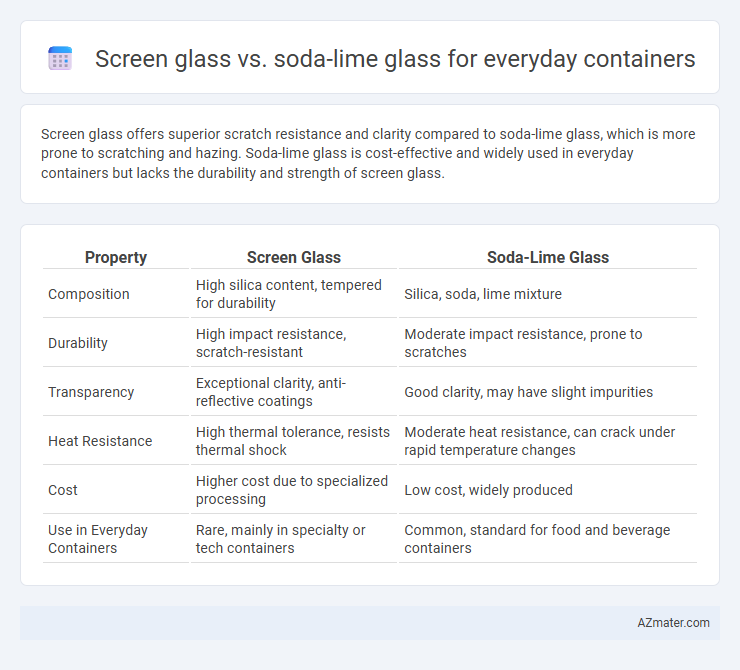Screen glass offers superior scratch resistance and clarity compared to soda-lime glass, which is more prone to scratching and hazing. Soda-lime glass is cost-effective and widely used in everyday containers but lacks the durability and strength of screen glass.
Table of Comparison
| Property | Screen Glass | Soda-Lime Glass |
|---|---|---|
| Composition | High silica content, tempered for durability | Silica, soda, lime mixture |
| Durability | High impact resistance, scratch-resistant | Moderate impact resistance, prone to scratches |
| Transparency | Exceptional clarity, anti-reflective coatings | Good clarity, may have slight impurities |
| Heat Resistance | High thermal tolerance, resists thermal shock | Moderate heat resistance, can crack under rapid temperature changes |
| Cost | Higher cost due to specialized processing | Low cost, widely produced |
| Use in Everyday Containers | Rare, mainly in specialty or tech containers | Common, standard for food and beverage containers |
Understanding Screen Glass and Soda-Lime Glass
Screen glass, designed for electronic devices, offers high optical clarity and strong durability against scratches and impacts, making it ideal for touchscreens but less common for everyday containers. Soda-lime glass, the most widely used glass type for containers, boasts excellent chemical resistance, cost-effectiveness, and easy recyclability, suited for bottles and jars in daily use. Understanding these properties highlights soda-lime glass's practical advantages in food and beverage containment compared to screen glass's specialized functionality in electronics.
Chemical Composition: A Comparative Overview
Screen glass primarily consists of silica (SiO2) with additives like boron oxide (B2O3) and alumina (Al2O3) that enhance thermal resistance and durability, making it suitable for electronic displays. Soda-lime glass, commonly used for everyday containers, contains approximately 70-74% silica (SiO2), 12-16% sodium oxide (Na2O), and 5-11% calcium oxide (CaO), providing cost-effective manufacture and moderate chemical durability. The differing chemical compositions directly affect properties such as thermal shock resistance and chemical stability, with screen glass offering enhanced performance for specialized applications, while soda-lime glass balances economy and strength for daily use.
Manufacturing Processes of Both Glass Types
Screen glass manufacturing involves a specialized tempering process that enhances durability and impact resistance, using controlled heating and rapid cooling techniques to create a tougher surface suitable for electronic displays. Soda-lime glass production follows a conventional melting and forming process where silica, soda ash, and lime are melted at high temperatures, then cooled slowly to form a versatile, cost-effective material commonly used in everyday containers. The contrasting thermal treatment in screen glass results in superior strength, while soda-lime glass prioritizes ease of shaping and economic efficiency in mass production.
Physical Properties: Strength and Durability
Screen glass exhibits higher tensile strength and superior impact resistance compared to soda-lime glass, making it less prone to cracking and shattering under stress. Soda-lime glass offers moderate durability but is more susceptible to scratches and breakage during everyday use. Enhanced composition and processing techniques in screen glass result in improved longevity and better performance for containers subjected to frequent handling.
Clarity and Transparency Differences
Screen glass, often made from chemically strengthened or tempered materials, offers higher clarity and better resistance to scratches compared to soda-lime glass, which is more prone to surface imperfections. Soda-lime glass, widely used for everyday containers, can have slight impurities that reduce transparency and may develop a cloudy appearance over time. The enhanced clarity of screen glass makes it ideal for applications requiring superior visual quality and durability.
Thermal Resistance and Usability
Screen glass typically offers superior thermal resistance compared to soda-lime glass, allowing it to withstand rapid temperature changes without cracking, making it ideal for everyday containers exposed to heat. Soda-lime glass, while more affordable and widely available, has lower thermal resistance and is prone to thermal shock, limiting its usability in high-temperature applications. For containers used in cooking or hot liquids, screen glass ensures durability and safety, whereas soda-lime glass suits general storage with moderate temperature exposure.
Cost Comparison: Affordability for Consumers
Soda-lime glass remains the most affordable option for everyday containers due to its widespread availability and lower production costs compared to screen glass. Screen glass involves more complex manufacturing processes, resulting in higher prices that may not be justifiable for standard consumer use. Consumers seeking budget-friendly containers typically prefer soda-lime glass, balancing cost-effectiveness with durability.
Environmental Impact and Recyclability
Screen glass typically contains specialized coatings and impurities that complicate recycling processes, leading to higher environmental impact compared to soda-lime glass. Soda-lime glass, the most common type for everyday containers, is highly recyclable and can be remelted repeatedly without significant quality loss, reducing landfill waste and conserving raw materials. Choosing soda-lime glass for containers supports circular economy practices by minimizing energy consumption and greenhouse gas emissions during recycling.
Common Everyday Applications
Screen glass, typically tempered and chemically strengthened, offers enhanced durability and scratch resistance ideal for smartphone and tablet displays, while soda-lime glass, composed primarily of silicon dioxide, sodium oxide, and calcium oxide, remains the standard for everyday containers such as jars, bottles, and glassware due to its cost-effectiveness and ease of production. Soda-lime glass withstands moderate thermal changes and is widely used in food storage, beverage bottles, and window glass, whereas screen glass prioritizes optical clarity and impact resistance for electronic device screens. The choice between the two depends on the balance of mechanical strength needed for interactive surfaces versus chemical stability and low manufacturing cost favored in everyday container applications.
Choosing the Right Glass for Everyday Containers
Screen glass offers enhanced scratch resistance and durability compared to soda-lime glass, making it ideal for everyday containers subjected to frequent handling. Soda-lime glass, while more affordable and widely available, is less resistant to impact and chemical corrosion, which can affect container longevity. For everyday use, selecting screen glass ensures better durability and maintains clarity over time, providing a more reliable option for long-term storage.

Infographic: Screen glass vs Soda-lime glass for Everyday container
 azmater.com
azmater.com